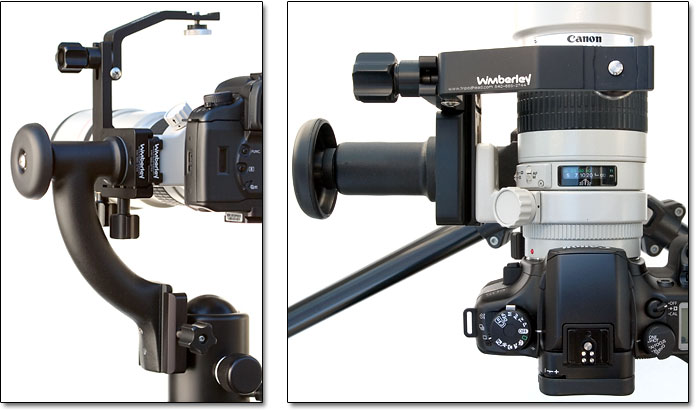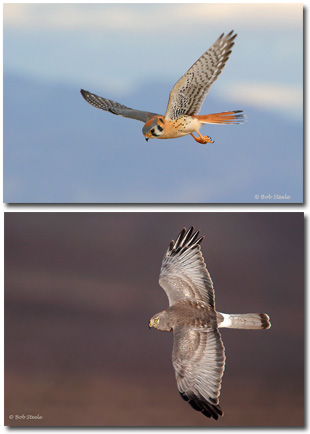The Wimberley Sidekick RevisitedText and photography copyright Bob Steele
Are you looking for a system that will allow fluid yet balanced “lens-flop-free” movement to track moving subjects with your heavy telephoto lens? Are you frustrated with trying to do just that with a ball head? If you have answered “yes” to both of these questions, the Wimberley Sidekick may be just the answer.
For lenses up to the size of a 500mm f4, the Sidekick is an economical way to turn a heavy duty ball head into a gimbal action mount. Smaller lenses can be used on the Sidekick as well provided there is a rotating collar on the lens. Like the full size Wimberley Head, the Sidekick works by creating a balance system that allows the lens to move about its own center of gravity. Smooth camera movements in both the horizontal and vertical directions are easy with the camera and lens properly positioned in the mount.
Setting Up the Sidekick

(Left) Wimberley Sidekick shown mounted in a Kirk BH-1 ball head with Wimberley Combo 6 Flash Bracket and Wimberley lens plates. (Right) Top view. Images copyright Jim Erhardt.
|
The Sidekick mounts in any heavy duty ball head that features an Arca Swiss style mount and a panning base – like the Kirk BH-1 or the Arca Swiss B1. The mount on the ball head is rotated over to the vertical position and the main ball knob is completely locked down. The Sidekick inserts into the ball head mount, which is also completely tightened down. That’s it, the Sidekick is ready to accept your lens. The lens foot needs its own Arca Swiss style plate and it has to be long enough to achieve balance in the system. Wimberley makes mounting plates for each lens that will work with the Sidekick. To mount the lens, lock the large tilt knob on the Sidekick and slide the lens plate in the partially loosened mount. Tighten up the Sidekick mount. Now check for balance by slightly loosening the tilt knob on the Sidekick while holding the camera. To achieve optimum balance, you may need to slide the lens forward or back until the lens will stay level on its own with the tilt knob on the Sidekick loose. This procedure must be repeated any time the camera and lens arrangement is changed, such as adding or removing teleconverters or extension tubes. With a little bit of practice, this adjustment becomes quite natural and easy. Personally, I can place the lens plate in the Sidekick mount within a fraction of an inch of perfect balance, regardless of the extension tubes or converters I’m using. Be absolutely sure to only loosen the Sidekick mount slightly during this adjustment to eliminate the chance of dropping your camera and lens. Lens plates with “stop” screws are a good idea to prevent an accidental loss of a lens by sliding out of a slightly loose Sidekick mount. With the camera and lens properly balanced, it will seem to float with the slightest touch.
In the Field
Once in the field, using the Sidekick is a pleasure. Slightly loosen the panning knob on the ball head and the tilt knob on the Sidekick and you are ready for the action. Following a bird in flight or a deer running across a meadow is effortless.
 And with the lens properly balanced, you can let go of everything at any time and not worry about “lens flop”. Users will find that the amount of tension on each of these two knobs can be set for individual preferences. I find that for birds in flight, I like to have just a little bit of resistance in each. But for following a warbler around a bush, no tension at all is the best. And with lenses that have image stabilization, these adjustments can be left loose and still get sharp images.
And with the lens properly balanced, you can let go of everything at any time and not worry about “lens flop”. Users will find that the amount of tension on each of these two knobs can be set for individual preferences. I find that for birds in flight, I like to have just a little bit of resistance in each. But for following a warbler around a bush, no tension at all is the best. And with lenses that have image stabilization, these adjustments can be left loose and still get sharp images.
Which side do you mount your Sidekick on? Although individual preference plays a roll in this decision, many have found putting the Sidekick on the left allows the quickest reactions to changing situations. With the Sidekick on the left, you will have to reach around it to perform manual focusing. However, tension adjustments to the vertical adjustment knob can be made without removing your hand from the shutter button.
Accessories
Flash Bracket Get your flash away from the axis of the lens and you’ll avoid the dreaded ‘red-eye’ or ‘steel-eye’ in most mammals and birds. Use the Wimberley Shape Shifter Modular Flash Bracket System to get your flash up and away from the lens. The Shape Shifter Combo 6 is specifically designed to work with the Sidekick.
Leveling Base Keeping your horizon level while panning is important. This can be difficult to achieve using only tripod leg adjustments, especially on uneven ground. The Gitzo G1321 Leveling Base solves this problem. Placed between the tripod legs and ball head, the base allows for up to 15 degrees of leveling.
Conclusion
The Wimberley Sidekick is a very economical alternative to the full size Wimberley Head for long lenses smaller than a 600mm f4, especially if you already own a heavy duty ball head. And it gives you the versatility to use the ball head for your smaller lenses too. Panning with a bird in flight, or following a warbler around as he feeds in a bush, is effortless due to the unique gimbal design that allows for weightless movement of your big lens. At only a little over a pound, it doesn’t add much additional weight to carry, a nice benefit if you travel by air or cover a lot of distance hiking with your gear.
The Wimberley Sidekick, flash bracket and lens plates are in stock and available for immediate delivery from the NPN Gift Shoppe.
BS-NPN 252
About the author...
Bob Steele has been involved in birding and bird photography for nearly 20 years.
In the past few years, bird photography has become his passion. He is also a
full-time engineer with the U.S. Navy. Bob lives in the bird-rich Kern
County, California. This area is centrally located at the convergence of
multiple bio-regions, giving him the opportunity to photograph many avian
subjects.
View more of Bob's work in his online portfolio at www.photoportfolios.net/bsteele and on his website at www.bobsteelephoto.com.
Comments on NPN photographic accessory reviews? Send them to the editor.


| 


